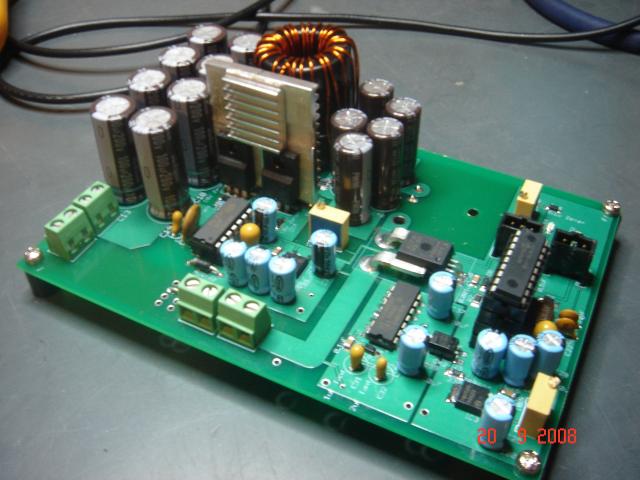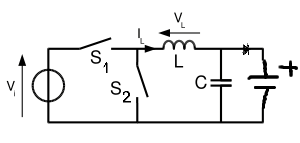I just wanted to let you all know how my MPPT controller was coming along. I posted pictures of it some time ago bu I still had not posted any test data. Here is a picture for refreshing out minds:

First I want to talk about the topology that I am using. I am using for this project a synchronous buck converter with a diode on the output like shown below.

The reason why I put a diode on the output was to help me during the development of the program that the micro controller will be running. If the diode is not in place there is a big possibility that under certain conditions like absence of input or duty cycle being too low the converter will then dissipate energy thought the low side MOSFET. This happens because MOSFETs conduct electricity both ways so if there is no input voltage the current from the batteries will flow backwards and over current the MOSFET if the duty cycle is too low.
On the final product this diode will not be there it is just there for now until the program is 100% bug free.
Recently I got a set for harbor freight like amorphous solar panels 3x15W panels. They are connected in series (36V nominal) and are located on my roof. I dont know what angle the roof is at, but this is a pretty standard house. Anyways... the power is transfered down thought roughly 50' (one way) 12AWG wire into a small knife switch and then into my MPPT controller.
Then the controller goes to an automotive 10A fuse and into two 6V 220Ah batteries in series (12V nominal) which I previously discharged to about 5V with a fan. (Thats the murder right there)
After letting the batteries charge for a bit their voltage went up to ~10.5V (10V is the min battery voltage for my controller to work). I recorded an efficiency of 86% with an output current of 2.1A into the 12V battery bank voltage quickly went from about 10.5V to 12.40V. I was expecting it to remain in the 10-11 volt range as it was supposed to be FAIRLY discharged. I thought 26W was very low power coming from a 45W solar panel array so I decided to reprogram the PIC and use a potentiometer to manually adjust the duty cycle and see the MPP myself.
Again I was disappointed with the output 26W so the algorithm was not the problem. Then I monitored the input power with amp+voltmeter. I found that the panels were just not delivering anywhere near the rated output. I have heard before that amorphous panels do not give the rated output until they are broken in dont know if that is true or not. If anyone has any info on it I will be very happy to get some feedback on this issue.
I tested the short circuit current to be almost 1A in full sun. The input voltage to my converter at MPP was 50V. The ambient temperature was ~25C, I have no clue about panel's actual temperature. Maybe the inclination of the roof is not optimal?
I know for certain there is no problem with my controller because I got the same results by handling it by hand as with the automatic algorithm and the efficiency is not bad at all for this little power range. That efficiency would have been much better if the array would deliver more power.
So please anyone with info on these panels let me know what you usually get into a 12V battery
I have not been able to do many tests on it because Ive been very busy lately but next time I will load the battery down to keep the voltage from going up to see how the current increases when the voltage decreases. Ill keep posting hopefully tomorrow.